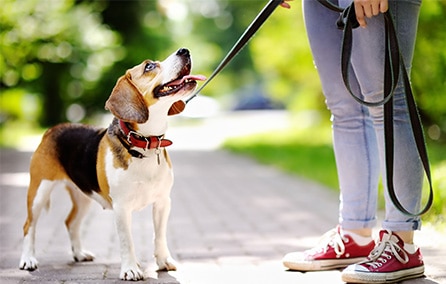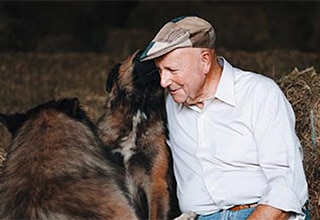- text
-
Dr Harry Cooper (AR No.1000933) is an Authorised Representative of PetSure (Australia) Pty Ltd (AFSL 420183). Any advice provided by Dr Harry Cooper in relation to Everyday Pet Insurance is general only and does not take into account your individual objectives, financial situation or needs.
Everyday dog walking tips and tricks.
Dr Harry shares his tips and tricks on walking your puppy.
Pet Insurance | 3 minute read | 23 January 2025
- Get a Pet Insurance quote online.
- Dr Harry: Everyday dog walking tips and tricks.
- Start dog training with a collar.
- Add some resistance to the dog lead.
- How to walk your dog.
- What’s the best harness for my dog?
- Vaccinations for a safe walk with your pup.
- Explore new places with your dog.
- Off lead dog walks.
- Bringing your dog to a dog park.
- Walking with dog friends.
- Get a Pet Insurance quote online today.
Dr Harry: Everyday dog walking tips and tricks.
Ever heard of The Rolling Stones hit song, ‘Walking the dog’? To quote just two lines “if you don’t know how to do it, I’ll show you how to walk the dog” and that’s exactly what this article is about. Getting your pup accustomed to walking can take some training but it can be easy if you start with these tips and tricks.
Like most dog training techniques it pays to start with your new puppy. You can teach an old dog new tricks from time to time but it generally takes longer. The younger brain is far quicker at learning. The following steps have worked for me over the years and like all training that we do with animals of any kind it's based on positive reinforcement. That simply means; that if you reward a certain behaviour (and that can be done with treats, a toy or praise) the behaviour will likely be repeated.

Start dog training with a collar.
Under the supervision of an adult, start with a collar and put it around the dog’s neck. For the first few times, leave it on for only a few minutes, offer a food reward and then remove the collar. Each day increase the amount of time the collar stays on and offer treats as the pup learns to tolerate the collar for longer and longer.
How tight should it be? The guide is always 2 fingers, held one on top of the other to separate the collar from the skin, but in toy breeds, it may need to be tighter. Once the puppy is happy to wear a collar without problems, attach a length of sash cord to the D ring. It's about three times as long as the puppy.
Tip: Once the puppy is happy to have this extra bit trailing along behind, extend it to the full length of a lead, anywhere from 1.5 to 2 metres. Likewise, do this under a watchful eye to make sure that no one gets tangled.
Add some resistance to the dog lead.
Now comes the real test. Take an old sock, and depending on the size of your puppy, add some sand and tie it to the end of the lead. Suddenly there is resistance when the pup pulls on the lead. Use rewards and praise. It's only a short step to picking up the lead and away you and the puppy go. But hang on there… you may very well have to hang on to some breeds, like those meant to pull sleds etc.
How to walk your dog.
Your puppy/dog should walk on your left side with its head adjacent to your leg and on a loose lead. How do you do this? Once again with food rewards. Walk in a bent over position and hold the food rewards against that left leg at the height of the dog’s head. Reward every so often.
What’s the best harness for my dog?
There are myriads of training harnesses and halters, and you need to try each to see what suits both you and your dog. So many dogs today walk on harnesses, which can sometimes limit the control you have during an emergency. It’s important to be aware that it can be very easy to be pulled over by a large dog. Your pup has 4 feet on the ground, and a low centre of gravity, you have 2 feet and a much higher and less stable centre of gravity.
I encourage all dog owners to ensure their pup attends a quality puppy pre- school, and then move onto a local obedience training club for a while where we can learn my version of Laurie Lawrences “Do the Five, Staying Alive’. Your pup will learn to Sit, Drop, Stay, Walk at Heel, and Come When Called.
Vaccinations for a safe walk with your pup.
All dogs should be vaccinated according to your vet’s protocols and wormed regularly. Dogs are great ‘sniffers’ and enjoy using their great sense of smell to explore the world. It is easy to inhale viruses and other pathogens through the nasal cavity. If you don’t give your dog a regular booster, its immune levels will slowly fall, sometimes to such a degree that the dog will not have enough antibodies to repel diseases like Distemper and Parvo Virus. Your dog is far more likely to pick up viral infections outside your home and backyard environment, such as the local park, where regrettably not every dog owner ‘cleans up’ after their pet.
Explore new places with your dog.
Do you think dogs get bored with the same walk every day? Scientific evidence says they do. So do we right? You can choose any number of routes where you can safely walk your dog and if they end up at a lead-free park or even a beach, so much the better. A short drive to somewhere new can be a real reward. Changing the routine does add another layer of excitement to the dog’s life.
If you are lucky enough to be able to walk in ‘the bush’, be aware of our native animals and keep your dog on a leash, but in here lies a huge treasure chest of smells. Dogs are so well equipped as most have long tapering noses and can detect smells up to 100,000 times better than we can.
When you get to a dog friendly open area, please be sure that you abide by the ethics of the place, and make sure you pick up anything your dog may leave behind. There is always a bin and some bags.

Off lead dog walks.
These are places where your dog can run freely. Take along a favourite toy or two. A tennis ball and a chuck-it-stick, a spinning disc (frisbee) or even a soccer ball for the bigger dog. You can try hiding a favourite toy and teaching your mate to find it using that trusty nose. It's also a place where you can practice essential obedience training. Some parks have quite an array of exercise equipment permanently set up, such as an apex, a high jump, a set of weave poles and maybe even a seesaw. Dogs love the challenge of something new. They also enjoy the interaction of meeting other dogs, as dogs are social animals.
Bringing your dog to a dog park.
While lead free parks and dog friendly areas were set up for the welfare of dogs and their owners, over time us vets have seen more altercations taking place through lack of owner responsibility. Some dogs unfortunately just do not get on with other dogs. This may be through a previous bad experience or may simply be part of the dog’s behaviour pattern. What is required is a more positive attitude on behalf of the owners of those dogs. They are better off being walked separately.
Tips: I am a great fan of muzzles. They work simply by preventing the aggressive dog from doing any damage should the owner lose control, and in my experience they often have a ‘calming effect’, as the dog seems to sense that it doesn’t want to pick a fight, if wearing one.
Walking with dog friends.
Walking with friends is another great activity. There are many dog owner groups that meet regularly, enjoying different locations and it is the dogs that are always the centre of attention. Walking your dog is such a simple pleasure that helps both you and your pet get in regular exercise. With those tips your dog will be your favourite walking companion.
Other articles you might like:
Get a Pet Insurance quote online today.
- text
-
Everyday Pet Insurance policies entered into for the first time prior to 17 July 2023 and subsequent renewals of those policies are issued by The Hollard Insurance Company Pty Ltd ABN 78 090 584 473, AFSL 241436 (Hollard), arranged and administered by PetSure (Australia) Pty Ltd ABN 95 075 949 923, AFSL 420183 (PetSure) and promoted and distributed by Hollard’s Authorised Representative (AR) Woolworths Group Limited ABN 88 000 014 675, AR 245476 (Woolworths). Everyday Pet Insurance policies entered into for the first time on or after 17 July 2023 and subsequent renewals of those policies are issued by PetSure and promoted and distributed by PetSure’s AR, Woolworths. Any advice provided is general only and does not take into account your individual objectives, financial situation or needs. Please consider the Product Disclosure Statement (PDS) to ensure this product meets your needs before purchasing, or choosing to continue with the product. PDS and Target Market Determination available at insurance.everyday.com.au/pet-insurance.



